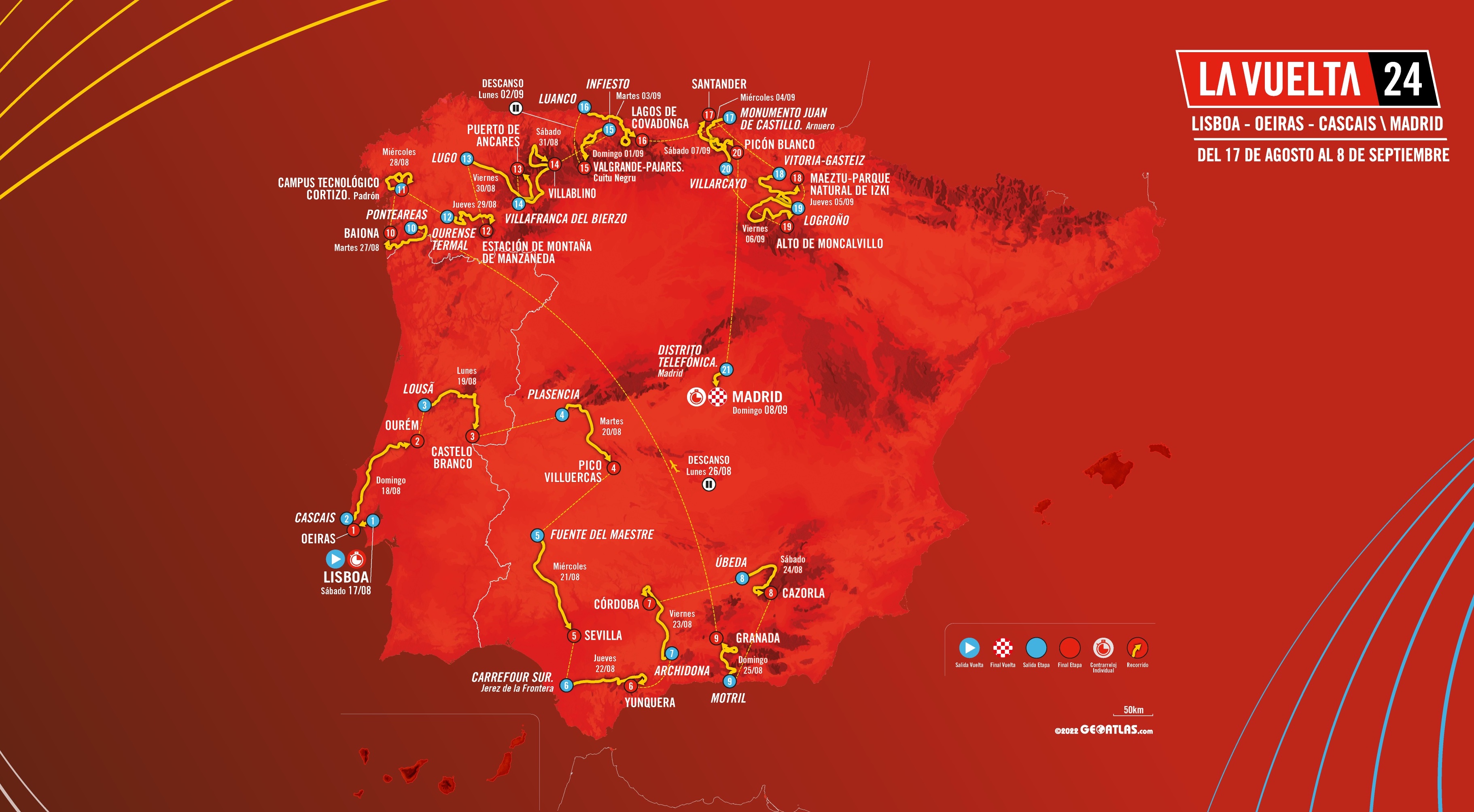
The route of the 2024 Vuelta a España is as typically climb-heavy as any of the recent editions of Spain's Grand Tour, but it will also conclude with a final individual time trial through the streets of the capital city, Madrid, for the first time since 2002.
Neither the Angliru nor the Pyrenees, two key mountain features of the 2023 route, will form part of the 2024 route, which was revealed on Tuesday evening in Madrid.
However, nine summit finishes, including the ascents of the ultra-hard Cuitu Negru and mythical Lagos de Covadonga in the second and third weeks, will ensure that another top mountain specialist will certainly be in the running to succeed American climber Sepp Kuss (Jumbo-Visma) as the overall winner.
Then, after what is arguably the toughest climbing day of all to the dauntingly difficult ascent of Picón Blanco in the northern province of Burgos on stage 20, 24 hours later, the 2024 Vuelta concludes on September 8 with a fast, flat 22-kilometre individual time trial in Madrid.
The full route in details
The 2024 Vuelta a España route kicks off for the fifth time in Vuelta’s history with a foreign start, this time in Lisbon, the capital of neighbouring Portugal, with a short, straightforward individual time trial that will decide the race’s first leader.
Two more hilly stages take the Vuelta back towards the Spanish frontier, with the race marking its return to Spain on stage 4 with a first summit finish on the rugged ascent of Pico de Villuercas, last tackled in 2021 with a win for France's Romain Bardet.
The first major mountain stage will come on much more familiar terrain on stage 9 when the Vuelta tackles two ultra-difficult cat.1 climbs in the foothills of the Sierra Nevada mountain range - the Purchil and a double ascent of the Alto de Hazallanas.
Both climbs featured in the hardest day’s racing of the 2022 Vuelta a España, on a stage where Primož Roglič (Jumbo-Visma) launched a searing late attack at the summit in a troubling setback for overall winner Remco Evenepoel (Soudal-QuickStep).
Rather than conclude in Sierra Nevada’s ski station like in 2022, next August, the Vuelta will descend back to the city of Granada for its finish, but even so, with so much climbing, stage 9 will likely be the first time the GC contenders come to the fore in the 2024 race.
A long transfer to Spain’s far northwest then follows, and after two rugged treks through the remote, hilly region of Galicia to open up week two of the Vuelta, a long, grinding ascent of the Manzaneda cat.1 climb on stage 13 will likely see the overall favourites back in action.
Stage 14’s much more challenging final climb of Ancares - the scene of a spectacular duel between Alberto Contador and Chris Froome in 2014 and with some notoriously rough road surfaces - will once again test the GC favourites prior to yet another hefty transfer, this time into the heart of the neighbouring Picos de Europa mountain range.
The Vuelta route presentation in Madrid on Thursday included a pre-recorded interview with Dario Cataldo as the only previous winner on the ski slopes of Cuitu Neru, the final climb on stage 15. Concluding with gradients of 24% and a daunting 19 kilometres long, the Italian allrounder recollected that it was “the steepest climb I’ve ever done in my life. At one point, I tried looking upwards to see where the finish was, and it was at such a steep angle, even though the finish was close, I nearly got a crick in my neck.”
Will the final race against the clock spark a GC upset?
After the little-known Cuitu Negru brings down the curtain on the second week, one of the Vuelta’s most classic ascents, the Lagos de Covadonga, opens up the interminable list of summit finishes on stage 16.
Tackled 22 times in the race since it was first used in the mid-1980s and well-known as home to some of the last wolves in western Europe, Covadonga has often decided the Vuelta’s overall classification, as it did in 2021 when Roglič all but wrapped up his third successive GC title.
This time, though, its role could be different, given stage 19 then features a return to the Alto de Moncalvillo, where Roglič and Richard Carapaz almost fought each other to a standstill in the 2020 Vuelta, and stage 20 comprises one of the toughest mountains stages of the entire 2024 route.
Finishing on the slopes of Picon Blanco, an ascent often used in the Vuelta a Burgos, stage 20 will be the last chance for the climbers to impact in the 2024 Vuelta a España, prior to a transfer south to the final time trial in Madrid.
It remains to be seen if the final race against the clock in 2024 will spark an upset of the scale of the 2002 Vuelta, the last time a final day TT was held in Madrid. That day, Aitor ‘Terminator’ Gonzalez managed to oust climber Roberto Heras from the overall lead on the last day possible.
But as Alejandro Valverde, a guest of honour in this year’s Vuelta presentation and teammate of Gonzalez in that year's Vuelta, put it, “that time trial is going to keep the riders on their toes right up to the very last metre of the final stage.” And it will certainly ensure that the 2024 Vuelta a España ends on a very different note to its traditional bunch sprint stage as well.







